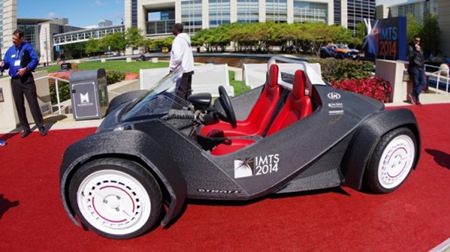3D printing has only become a possibility in the last few years, though the adoption of this technology is spreading. The list now includes 3D printable human tissue, to a 3D printed life-size castle, and now a 3D printed car.
At the International Manufacturing Technology Show (IMTS) in Chicago, Arizona-based automobile manufacturer Local Motors stole the show. Over the six days of the IMTS, the company managed to 3D print, and assemble an entire car, called the ‘Strati’, live in front of spectators.
Even though the Strati is not the first car to be 3D printed, the advancements made by Local Motor with help from Cincinnati Inc, and Oak Ridge National Laboratory, produced a vehicle in days rather than months.
 3D printed car.
3D printed car.
In 2013, engineer Jim Kor designed the Urbee 2 3D printed car. The vehicle which weighed about half of what a typical automobile would weigh, was as strong as steel. What set Local Motor’s ‘Strati’ 3D printed car apart from the Urbee 2, was the fact that they managed to print and construct the entire vehicle in just six days, whereas the Urbee 2 took 2500 print hours to complete.
The breakthrough was made possible by a machine produced by Cincinnati Inc., in cooperation with the Oak Ridge National Laboratory. The Big Area Additive Manufacturing (BAAM) machine is capable of printing at much faster speeds than traditional 3D printers. It can lay down up to 20 kg of carbon infused ABS plastic per hour, with precise accuracy. After an exciting six days of printing, in front of a live audience, the vehicle was finally complete.
To show that this was not just an automotive work of art, the car, which features just 40 parts, drove out of McCormick Place in Chicago. Local Motors’ next plan to do after the Strati 3D printed car, is to seek to launch production-level 3D printed vehicles for sale to the public in the coming months.
Having seen video clips of this machine (I call it that rather than “car”) it is fairly basic, but is definitely a portent of what is to come. Many parts of F1 cars are made using 3D printing. The family run-about will be next, and finally an eco-car with the 3D printing process producing parts around half the weight of conventional items.




